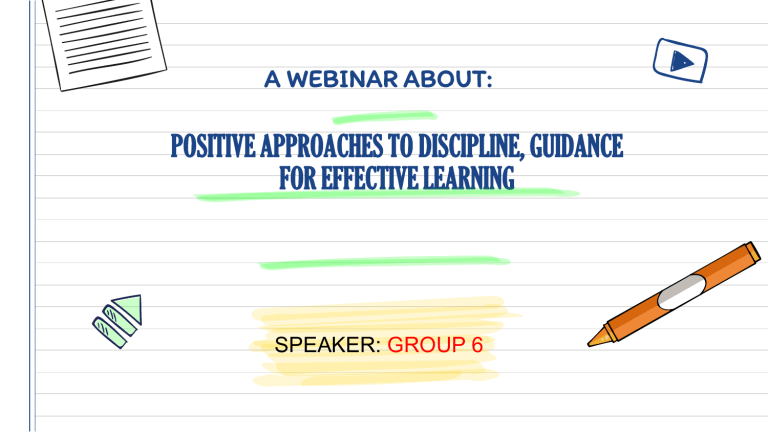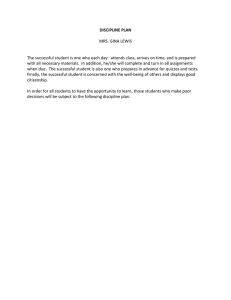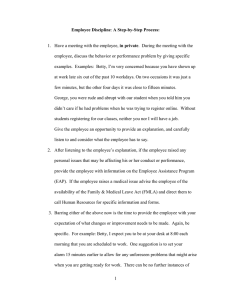
A WEBINAR ABOUT: POSITIVE APPROACHES TO DISCIPLINE, GUIDANCE FOR EFFECTIVE LEARNING SPEAKER: GROUP 6 POSITIVE APPROACHES TO DISCIPLINE GUIDANCE FOR EFFECTIVE LEARNING WHAT ARE WE GOING TO DISCUSS? In this webinar, were going to discuss the following: Causes of behavioural problems in children in various educational platforms Understanding why children behave as they do Characteristics of children with behavior problems The Positive Reinforcement Techniques/Positive Techniques in Managing Behavior of Students The Concept of Guidance WHAT ARE WE GOING TO DISCUSS? The Need for Guidance at all School Levels The Classroom Teacher as a Guidance Worker Guidance Services How to Implement Guidance Programs in the New Normal WHAT CAUSES OF BEHAVIOURAL PROBLEMS IN CHILDREN IN VARIOUS EDUCATIONAL PLATFORMS? Children skills differ as they grow, each stages of growth extends not only on the maturity of the child as well as his/her capabilities to cope with certain changes in environment in which changes in behavioral aspect is observable, here below are the common causes why children’s behavioral may change : ● Child–parent interaction problems ● Unrealistic expectations ● A self-perpetuating cycle ● Discipline problems Behavior is like a lighthouse, it serves as our guide on how to react on certain actions given by children. In understanding one’s behavior, we must consider first the following: • • • • If behavior is effective – then, it works. Behavior can be controlled. An alternative behaviour can be taught to replace challenging behaviour. If you meet the need, you address the unwanted behaviour. Naturally speaking, Children behave the way they behave because they think the way they think. WHAT ARE CHARACTERISTIC OF CHILDREN WITH BEHAVIOR PROBLEMS? Behavioral problems or others called it “ emotional disturbance” vary from one child to another, some children may have this kind of behavior which manifest certain characteristics. What are this common characteristic that sometimes we can observe? • • • • • Hyperactivity (short attention span, impulsiveness); Aggression or self-injurious behavior (acting out, fighting); Withdrawal (not interacting socially with others, excessive fear or anxiety); Immaturity (inappropriate crying, temper tantrums, poor coping skills); and Learning difficulties (academically performing below grade level) These behaviors may continue over long periods of time. Meaning, this signals that they are not coping with their environment well or with peers. Positive Techniques in Managing Behavior of Students involves: • good limit setting • clearly communicating limits • Teaching more appropriate behavior • giving cues for the new behavior • giving choices, and supporting children in their new behavior. • ignoring behavior when it is appropriate to do so. “Helping children save face and preserve their dignity in discipline encounters is the most important and essential element in child guidance.” - Unknown DIFFERENCE BETWEEN DISCIPLINE Is directed at the objectionable behavior, and the child will accept its consequences without resentment. PUNISHMENT A response that is directed at the individiual. It represents a desire of one person to hurt another; abd it is an expression of hostility rather than corrective love. WHAT CAN YOU SAY ABOUT THIS PICTURES? THOSE PICTURES TELLS US THAT PUNISHMENT ITSELF: • • • • Inflict pain Impose suffering Enforce unrelated penalties Involves personal or emotional attack WHAT IS EFFECTIVE DISCIPLINE? WHAT ARE THE POSITIVE APPROACHES TO DISCIPLINE? TRAINING APPROACH also referred to as training model. It calls for a frequent repetition of good acts until they become habits. WHAT ARE THE POSITIVE APPROACHES TO DISCIPLINE? BEHAVIOR MODIFICATION APPROACH called as the behavior modification model. Good behavior is reinforced and misbehavior discouraged. WHAT CAN WE DO FOR GUIDING THE LEARNERS TOWARDS EFFECTIVE LEARNING ? understand your child's major job at different ages. Do not expect too much from your child too soon (like expecting a three-year old to tie his shoes). Prevent serious problems, provide safe ways for your child to do her job and be ready to move on to the next stage. STEPS IN POSITIVE DISCIPLINE • • • • • • Ignore minor, irritating behavior. Praise and reward positive behavior. Be specific with praise. Work with the child to set basic rules. Decide together what consequences will result from breaking the rules. Use consequences consistently and calmly when rules are broken CONNECTION BETWEEN DISCIPLINE & GUIDANCE FOR EFFECTIVE lEARNING To recognize one’s importance to society, his/her contributions to its stability and progress, and his /her readiness and willingness to adjust himself to the standards of society. Both aim positive feedback regarding one’s behavior and action DISCIPLE & GUIDANCE They support a development of well-being for learners to manage oneself. They always go together Thank you for listening! CREDITS: This presentation template was created by Slidesgo, including icons by Flaticon, and infographics & images by Freepik.

